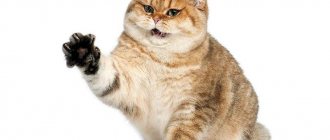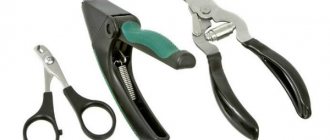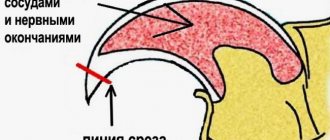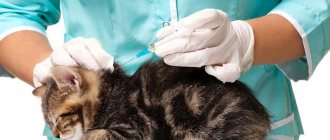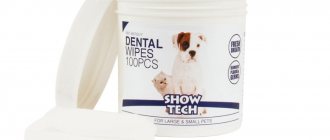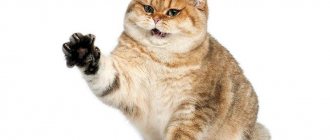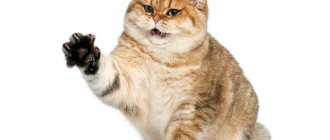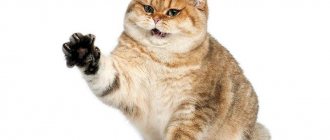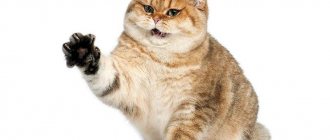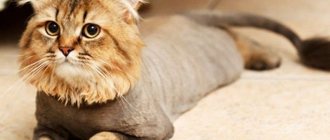Ancient Egypt is considered the birthplace of cats. The first domestic cats appeared on earth many years ago among the Egyptians; this fact is mentioned in the works of the ancient Greek historian Herodotus. Smart and independent tailed creatures immediately won the hearts of people.
According to the latest estimates of felinologists, there are more than 50 varieties (breeds) of cats living on earth. They can rightfully be considered the most popular pets. But although there is an opinion about the independence of these mustachioed pets, both cats and female cats require attention, care and care from their owners. And the most difficult thing on this list of activities is cutting nails at home. But whether it is necessary to cut a cat’s claws and how to do it, we will consider in this article.
Claws as a natural means of attack, defense and a tool for practical use
The cat is considered a predatory animal, and its claws are a real tool for hunting and survival. Although, in a home environment, she does not have the need to hunt and get her own food in this way.
Cats' claws grow throughout their lives. And so the fluffy mustaches are trying to renew them. And since modern domestic cats have almost lost the skills of climbing trees, which contributed to the natural grinding of their claws, the animals scratch and tear off furniture and corners in the house.
By scratching objects, cats get rid of keratinized and dead scales on their claws, freeing the healthy part.
It is a cat's instinct and physiological need to care for its claws from the earliest months of life. Kittens begin to gnaw their claws, sharpening them in this way. They also cling and climb wherever they can catch their claws, honing the innate skills of a predator-hunter.
Scratching post for cats: how to train, tips
Few people know, but mustachioed pets can leave traces invisible to humans. On the pads of their paws there are special glands that secrete a secret that can only be smelled by animals. When cats scratch furniture, they also mark their territory and its boundaries.
Thanks to the claws, it is easier for the animal to maintain balance when walking and use them as a support when jumping and climbing to heights. And naturally, the basic function of claws is protection during attacks by enemies .
Other solutions
Cats have a natural instinct - they take care of their claws themselves. Starting from the age of one month, kittens sharpen them with their teeth, scratch the bedding, use a scratching post or other objects, removing the dead outer shell of the claw.
To preserve furniture and other interior items from damage, owners are looking for various options. A good method of training and protecting furniture is a scratching post. You can buy it at a pet store or make it yourself. A board or post with a rough hard covering is installed in a place accessible to the pet. If you teach your kitten to use the device from childhood, you can keep the sofa and wallpaper in the room.
Pet stores sell special silicone claw covers. Their advantage is that the cat can calmly play with small children and sharpen its claws on any surface without fear of leaving damage. However, it is not recommended to use them for a long time, and even more so, you should not put the pads on animals that are walking on their own: in case of danger, the cat will not be able to climb a tree or rise to a different height.
Best articles: Ten interesting facts about cats
The most cruel decision of the owners is to remove the claws. In most countries of the world, this manipulation is strictly prohibited and is punished as cruelty to animals. During the operation, not just a claw is removed, but part of the phalanx - almost the same as cutting off a person’s fingers. This cripples the animal and makes it disabled.
After onychectomy, performed under anesthesia, which in itself is dangerous for the cat, the structure of the skeleton is disrupted, and this negatively affects the functioning of all body systems. The cat is not only exposed to stress and danger - its coordination and sense of balance are impaired, it can fall even from a small height and be seriously injured.
Animals' character changes, they become irritable and even aggressive. Therefore, it is much easier to teach a kitten to use a scratching post from an early age and regularly trim its sharp claws.
Structure of a cat's paw
The cat has five toes on its front paws and four on its hind paws, each toe ending in a crescent-shaped claw. A cat's claws are nothing more than keratinized layers of white epidermis. The reliability of their claws is due to the high content of keratin protein in them.
Review of the best online games for cats
Cat claws are highly sensitive. And only the very tip of the nail is less sensitive to various types of damage, and the rest of it has a pulp underneath with blood vessels and nerve endings.
Accordingly, deep damage to a cat’s claw is very painful.
On the cat's paws (on the toes and middle of the foot) there are leather, hairless pads, thanks to which the cat moves silently and provides better shock absorption when jumping. The pads are equipped with highly sensitive nerve endings and blood vessels. And thanks to the work of tendons, cats can retract their claws between the pads.
When walking, cats rely only on their toes, not on their entire foot, and the cat's heel does not touch the ground.
Something sharp with the letter “k”: features of the anatomical structure
Opponents of such an extreme measure claim that it is painful for the animal, because during the “execution” it experiences nothing but pain and fear, and frequent cutting can lead to damage to blood vessels. Is it so? Let's turn to anatomy to make sure that not everything is so simple.
We all know that the claws are located on all four legs of the beast, which can control them like Wolverine from Marvel comics - retracting and releasing. In the first case, they are hidden in the folds of the skin. At such moments, the cat’s paws are soft - nothing threatens both you and your furniture.
An interesting fact is that cheetahs, although they belong to the cat family, differ from all their counterparts, including domesticated ones, in that their claws do not retract.
The claw is hidden under the influence of a tendon, which also allows the cat to release the tip, which is dangerous for home textiles and your hands, when the animal is excited or ready to attack its prey.
The claw is shaped like a sickle - which is why it is so convenient for them to hold something and injure the enemy during a fight. The part that we see consists of the living part and the stratum corneum. The first contains the processes of nerve fibers and blood vessels, the second is subject to grinding and is shed from time to time, like an old snake skin.
So all the fears of those who oppose cutting are quite logical and justified. The plate must be cut carefully so as not to touch the nerve endings or damage the translucent vessel.
Pets belonging to some breeds may have serious problems with their claws: they can peel off and grow until it begins to cause discomfort to the animal. Most often, this happens to Persians if they lack vitamins B or D. If you have a Sphynx or other hairless cat, you need to check your pet’s paws for the formation of a secretion produced by the sebaceous glands - it accumulates in the comb bed and is removed every three days .
Why do you need to cut your hair?
Do I need to trim my nails and why? The answer to the question depends on the animal’s lifestyle. If a cat spends a lot of time outside, climbs trees and hunts for rodents, then she cannot do without sharp and long claws. And during her activities, the claws wear down naturally and do not need to be trimmed.
Apartment sofa couch potatoes need this procedure primarily for hygienic purposes .
- Firstly, trimming nails prevents their abnormal growth. Some mustachioed breeds, by their nature, are not able to retract their claws completely, and therefore owners often have to trim their cats' claws so that walking does not cause them pain.
- Secondly, for owners, scratches with sharp claws are dangerous and can lead to serious consequences, since bacteria that penetrate into the human blood, carried by cats, cause a number of diseases, including fever and mental disorders.
The cat's safety also depends on the length of the claws. Claws that are too long and sharp can cause injuries in the event of a fall from a height.
An important argument in favor of haircuts is the preservation of furniture, wallpaper, door frames, curtains, as well as the preservation of a calm psychological environment in the house and the nerve cells of the owners. After all, it is the need to sharpen their claws that provokes pets to test the strength of all these objects.
Why cats scratch and bite their owners: reasons and how to fight
How often should you trim your nails?
The number of procedures for cutting claws varies, and this is not surprising - the characteristics of each cat’s body are individual. For one cat, it is enough to trim its claws once a month; for another, the treatment will need to be repeated three or even four times. Be guided as the claws grow. If the cat is accustomed to a scratching post, then she will naturally partially grind off her claws, which will prolong the effect of trimming. And if you haven’t managed to develop such a useful habit yet, you can read our effective tips for teaching a scratching post.
As a rule, the more often you trim your nails, the better, even if you trim just a little at a time. By trimming its claws too infrequently and with slow growth, the cat will have time to wean itself off the necessary procedure, and you will have to retrain it.
Claw care is especially important for cats attending exhibitions. For them, cutting nails is not only a hygienic procedure, but also a cosmetic one, since all exhibition animals must not only be healthy, but also look impeccable.
Required Tools
Pet stores offer a wide range of special tools to properly trim your cat's nails.
Nail clippers . These include special pruning shears, reinforced wire cutters, or nail clippers. These are all mechanical tools with a round claw cutout. But they all have one big drawback - the owner who is cutting the claw has difficulty seeing the length of the claw and the place from which it needs to be cut off.
Guillotine trimmer . This is a modern device, easy to use. With its help, the cut is made as rounded as possible. But there is also a drawback here - a working trimmer makes noise, which can frighten an already fearful pet.
Grinder . This is a sharpening stone with an abrasive coating that can be used to painlessly sharpen a claw and polish it.
Regular manicure scissors . But they must be used with caution and only for trimming soft tissues in kittens. This tool is not at all safe for adult cats.
It is important that all these tools are well sharpened and their handles are covered with non-slip material. Before use, the instrument must be treated with a disinfectant.
You will also need an antiseptic to stop the bleeding if a wound forms.
Top 5 Misconceptions About Cats You Believed
Price for nail trimming
| Name of veterinary services | Unit | Price, rub |
| ⭐ Nail trimming | 1 animal | 300 |
| ⭐ Beak trimming | 1 animal | 300 |
| ⭐ Cleaning the anal glands | 1 animal | 300 |
| Hygienic cat grooming (with removal of mats) | 1 animal | 2000 |
| Sanitary animal grooming: | ||
| – small animals (up to 5 kg) | 1 animal | 1650 |
| – medium animals (over 5 kg to 15 kg) | 1 animal | 2750 |
| - large animals | 1 animal | 4400 |
| Sanitary washing of animals: | ||
| – small animals (up to 5 kg) | 1 animal | 550 |
| – medium animals (over 5 kg to 15 kg) | 1 animal | 3300 |
| - large animals | 1 animal | 5500 |
CLINIC REGISTRATION
HOME CALL
Haircut instructions
The procedure for trimming nails is not simple and consists of several stages that require certain preparation.
First you need to choose the right time. It is better if the cat is sweetly dozing or in a good mood. The position of the cat should allow the owner to fix it without causing discomfort or pain.
The claws of the tailed furry need to be treated with an antiseptic to avoid dirt or dust getting into the wound.
Now you can begin the procedure itself. It is necessary to expose the claws by pressing on the central pad of the paw. A bare claw will help you clearly see the pink part with blood vessels and nerve endings and determine the location of the cut.
Only the transparent part of the claw is trimmed . If you cannot determine the location of the cut - the border with the pink pulp is not visible - you need to cut off 1 or 2 mm from the rounded tip of the claw.
It is very important to hold the tool correctly towards the growth of the claw and make the cut at the required angle so that the edge of the claw remains pointed. Cutting at a different angle may cause nail separation or pulp damage.
When grooming, it is important not to forget to trim the claw on the fifth toe of your pet’s front paws. This finger is often forgotten, which is why it can cause pain to the cat by digging into the pad on the paw.
How to properly trim a cat's claws
Before you begin the exciting procedure, you need to make sure that the cat is in a good mood. The state of mind of the owner is also important. He must exude positivity, goodwill and at the same time – inflexibility and self-confidence. Under no circumstances should you fuss.
- Place a light near your work area so that you can carefully examine the claw, determining where the pulp begins.
- Wash your hands with soap, treat them with an antiseptic, and disinfect your chosen nail trimming tool.
- Gently sit the cat on your lap (with its back facing you), take the paw that you will treat first in your hand, and hold it firmly. If the animal begins to actively object, swaddle it in a towel or dress it in overalls. You may need to call an assistant to help.
- Gently press the center of the pad with your fingers to extend the claw to its maximum length.
- Place a nail clipper (scissors) on the curved part of the claw, choosing the correct angle - along the line of its growth, that is, the trimmed claw should not differ in shape from the untrimmed one. The cutting direction is from bottom to top.
- Stepping back at least 2 mm from the edge of the pulp, cut off part of the claw in one motion.
- If there are any rough spots left on the claw, you can get rid of them using a nail file, a diamond-cut file, or a whetstone. Just keep in mind that friction usually causes extreme irritation and anxiety in the animal. In addition, there is a risk of delamination of the claw if its edges are processed with excessive force. The pressure should be light.
- Trim all the claws, then give the cat a treat, even if she has not shown submissiveness.
Don't forget that the fluffy has 18 toes with claws (5 on the front paws and 4 on the back paws). At the end of the procedure, it is advisable to make sure that you have processed each one. One forgotten sharp claw can create discomfort for an animal.
Where do cats have their nails trimmed?
Of course, the nail trimming procedure will be safer and more painless for the animal if a professional - a cat groomer or veterinarian - gets down to business. And the owner will not have to worry about this.
But not all cats like to visit veterinary clinics; the presence of other animals and smells can cause stress in a pet. In this case, you can invite a specialist home; in a familiar environment, the cat will feel calmer.
But there is nothing bad or terrible in the fact that the owner does it himself at home. The main thing is that he approaches the procedure responsibly and first studies information on how to trim a cat’s claws at home.
But we still recommend that the first nail trimming be done by a professional, so that the fluffy will be calm about such procedures in the future.
How to properly clean cats ears at home
Preparation for the procedure
Who else but the owner knows the habits and character of his beloved pet, so he can adapt to it. Nervous, aggressive animals react ambiguously to any procedure. It will be good if 2 people cut the cat’s claws. A cat that is struggling should not be forced, otherwise trimming its claws can lead to injuries on both sides. You just need to wait for the animal's favor before attempting to trim the nails again.
Accustoming an animal to procedures usually begins at the age of a kitten. A small pet should not be afraid of having its paws touched. To trim claws, you should prepare the tools and place them on the table. It is recommended to take the cat in your arms, stroke its back, touch each paw so that it calms down. If the pet is unfriendly and wants to run away, there is no need to forcibly restrain it. It is impossible to do the procedure in this condition; it is advisable to wait 2-3 days.
If the cat behaves peacefully and does not resist touching, it is worth praising it and giving it a treat. He will get used to getting food for this and will allow you to touch his paws. You should talk to your pet, at the same time stretch your fingers one by one, and at the same time inspect the claws. A cat that trusts its owner will not interfere with such manipulations.
Useful tips
- If your pet is agitated or resists the procedure, nail trimming will have to be postponed.
- To prevent your cat from becoming stressed, it is better to treat one paw a day until the procedure becomes familiar to her.
- It is important not to forget about trimming the claws on the fifth toes of the front paws and the claws on the hind paws.
- After completing the procedure, you need to treat the cat with its favorite treat.
- If your cat is stressed due to the procedure, you can offer her sedatives using natural herbs.
The main thing in this simple and complex matter is to develop your own effective strategy and follow it constantly. Well, if the cat under no circumstances allows either the veterinarian or the owner with scissors to approach him, you can use silicone pads - anti-scratch claws. Love your mustachioed pets! Meow!
What to do if the cat is against it?
Many cats hate bathing, brushing, and any attempts to tidy up their fur. Some scratch and bite heavily. For a biting cat, you can use a muzzle, but sometimes a muzzle does not help, because... the brutalized animal manages to remove it or even bites it through the fabric. In this case, a special plastic helmet, which was recently invented by the Chinese, will come to the rescue. The cat definitely won't chew it through. Once again, the Chinese managed to come up with a great thing that helps against especially evil cats!
What to do when the animal is not given?
Pets have different temperaments. There are aggressive and nervous cats. They are unlikely to allow their nails to be trimmed in peace. Most likely, the animal will scratch, bite, and break out.
If the cat does not give in, you cannot show force: this can injure its paws. It is advisable to perform the procedure by two people: one holds, the other trims the claws. You can also swaddle your pet or wrap it in a blanket.
If he is very nervous, it is better to refuse the event and do it when the animal is more pliable and balanced.
At what age can you start?
If the breeder has never trimmed the puppy’s nails, then try to accustom the baby to cutting his nails literally from the first days of his stay in your home.
If you have acquired a 2-month-old baby, then it is quite possible to accustom him to this procedure . After all, the sooner you start, the easier it will be for you in the future, since the pet will not be afraid and nervous.
Expert opinion
Kozhevin Semyon Kirillovich
Expert dog handler.
“Experienced breeders try to start trimming puppies’ nails as early as possible, from about 1.5 to 2 weeks of age. This is necessary so that the baby does not scratch the mother’s mammary glands and she does not refuse to feed. Sometimes, such a haircut is a matter of survival of the whole litter. And since puppies’ nails grow quickly, they are trimmed at least once every 2 weeks. For an adult dachshund, one haircut per month will be enough.”
How to trim a kitten's claws - nail clippers and improvised tools?
Let's say you have an urgent need to give your pet a manicure. How to trim nails yourself without harming your pet? If you have a nail clipper, the task becomes easier. If the kitten is about to have its nails trimmed for the first time, and you don’t have the tools, you can use improvised media while observing safety precautions.
Important! Don't set yourself the task of trimming all of your kitten's nails at once. If you were able to cut one claw in one approach, this is already a success.
Regular scissors
The first thing that comes to the mind of an inexperienced owner is to trim the pet’s claws with ordinary scissors, but is this possible? Hypothetically, you can...if:
- The cat will not twitch.
- You have a steady hand.
- The cat has thin claws.
- You only need to trim the ends.
What could go wrong? The structure of a cat's claws is significantly different from that of a human. When using regular scissors to trim nails, there is a very high probability of:
- Crushing a claw is very painful.
- Injuring your finger if the cat pulls its paw is even more painful.
Have you injured your pet unknowingly? In such a situation, it is extremely important to quickly stop the bleeding and ensure that the wound does not become infected. The injured claw will grow back, after which it needs to be trimmed. If the wound looks serious or your finger is injured, it is best to consult a doctor. If you don’t have nail clippers at hand, and your claws urgently need to be shortened, it’s wiser to use a nail file or nail scissors.
Nail scissors
A small kitten (1-3 months old) can have its nails trimmed with nail scissors. The only nuance is the model of the scissors. Nail scissors can be distinguished by their tips:
- Curved - for cuticles.
- Direct.
- Rounded – safe for cutting off hangnails and corners of nails.
Nail scissors with rounded tips are suitable if the nails need to be blunted rather than trimmed. Simply put, if you only need to cut off the ends so that the baby does not cling to the bedding and injure himself, you can hold off on buying nail clippers.
Can nail clippers be used to trim nails?
Nail clippers (for humans) are one of the most common tools used by inexperienced owners to injure cats. To painlessly shorten your pet's claw, you need to cut it at an angle. The blades of the tweezers close straight, but in order to set them at the desired angle, the cat's paw will have to be bent at an unnatural angle.
Again, if your pet has an exceptionally calm temperament and lies motionless in any position during the procedure, tweezers are suitable. If the pet jerks its paw when the claw is caught between the blades, it will be injured. By the way, if you use tweezers, even veterinary ones, the pressure on the handles should be firm and sharp. By cutting the claw slowly and smoothly, you risk crushing it.
How to use a guillotine correctly
Have you bought nail clippers and don’t know how to use them? The good news is that the guillotine is easy to use and the procedure is safe. The second news is that you probably won’t be able to trim all the claws the first time.
First, check your pet's reaction by touching the guillotine to the claw. Click the claw clipper and watch the reaction again. If the cat does not pull back its paw, you can try cutting it. Be sure to hold your pet's paw with your free hand. Cut off only the tip (sharper) of the claw. Your movements should be confident and firm. The guillotine cuts the claw at an angle, so the pet should not experience any discomfort.
